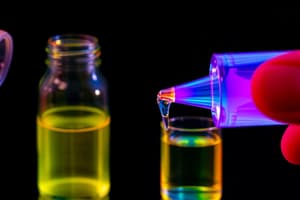Podcast
Questions and Answers
What is the result of the equation $\text{acid} \times \text{Eqwt} = \text{COOH groups}$?
What is the result of the equation $\text{acid} \times \text{Eqwt} = \text{COOH groups}$?
- It represents a chemical equilibrium process.
- It indicates the molecular weight of an acid.
- It shows the number of COOH groups in an amine. (correct)
- It describes the concentration of an acid.
The number of COOH groups in an amine is equal to the weight of one COOH group multiplied by the total weight of the acid.
The number of COOH groups in an amine is equal to the weight of one COOH group multiplied by the total weight of the acid.
False (B)
What does COOH stand for in chemical terms?
What does COOH stand for in chemical terms?
Carboxylic acid group
The number of COOH groups in an amine can be calculated using the weight of one COOH group divided by the weight of the ___ acid.
The number of COOH groups in an amine can be calculated using the weight of one COOH group divided by the weight of the ___ acid.
Match the following terms with their descriptions:
Match the following terms with their descriptions:
What units are generally used to measure the weight of an acid?
What units are generally used to measure the weight of an acid?
The weight of one COOH group is always constant regardless of the acid.
The weight of one COOH group is always constant regardless of the acid.
What is the primary function of the COOH group in organic compounds?
What is the primary function of the COOH group in organic compounds?
The formula for the number of COOH groups in an amine is given by the weight of one COOH group divided by the weight of the ___ acid.
The formula for the number of COOH groups in an amine is given by the weight of one COOH group divided by the weight of the ___ acid.
Which of the following statements is NOT accurate regarding COOH groups?
Which of the following statements is NOT accurate regarding COOH groups?
What formula determines the percentage of nitrogen?
What formula determines the percentage of nitrogen?
The term 'halogen' refers to a category of elements that includes nitrogen.
The term 'halogen' refers to a category of elements that includes nitrogen.
What is the role of pyridine in the context of catalysis?
What is the role of pyridine in the context of catalysis?
The formula for calculating the percentage of halogen is ______.
The formula for calculating the percentage of halogen is ______.
Match the following substances with their corresponding formulas:
Match the following substances with their corresponding formulas:
Which equation represents the calculation for the weight of one NH₂ gram?
Which equation represents the calculation for the weight of one NH₂ gram?
The equation for the percentage of NH₂ is $#NH2 ext{ }g =
rac{W_t ext{ }NH2 ext{ }g \times 100}{W_t ext{ }amine}$.
The equation for the percentage of NH₂ is $#NH2 ext{ }g = rac{W_t ext{ }NH2 ext{ }g \times 100}{W_t ext{ }amine}$.
Define the term 'amine' in the context of chemical structures.
Define the term 'amine' in the context of chemical structures.
The equation for the percentage of COOH is ______.
The equation for the percentage of COOH is ______.
In the formula % halogen = (W_t halogen / W_t sample) * 100, what does 'W_t' stand for?
In the formula % halogen = (W_t halogen / W_t sample) * 100, what does 'W_t' stand for?
Flashcards
Molecular Weight (MWt)
Molecular Weight (MWt)
The mass of one mole of a compound, expressed in grams per mole.
Equivalent Weight (Eqwt)
Equivalent Weight (Eqwt)
The mass of one mole of a specific functional group, expressed in grams per mole.
Weight of one COOH group
Weight of one COOH group
The mass of one mole of a carboxylic acid group (COOH).
Number of COOH groups in an organic acid
Number of COOH groups in an organic acid
Signup and view all the flashcards
Number of COOH groups
Number of COOH groups
Signup and view all the flashcards
Microanalysis
Microanalysis
Signup and view all the flashcards
C1A1 = CxA
C1A1 = CxA
Signup and view all the flashcards
Microanalysis - Percentage Calculation
Microanalysis - Percentage Calculation
Signup and view all the flashcards
Percentage of Nitrogen Calculation
Percentage of Nitrogen Calculation
Signup and view all the flashcards
Percentage of Halogens Calculation
Percentage of Halogens Calculation
Signup and view all the flashcards
Percentage of Amine Calculation
Percentage of Amine Calculation
Signup and view all the flashcards
Amount of Amine Group Calculation
Amount of Amine Group Calculation
Signup and view all the flashcards
Number of Amine Groups Calculation
Number of Amine Groups Calculation
Signup and view all the flashcards
Percentage of Carboxylic Acid Calculation
Percentage of Carboxylic Acid Calculation
Signup and view all the flashcards
Amount of Carboxylic Acid Group Calculation
Amount of Carboxylic Acid Group Calculation
Signup and view all the flashcards
Study Notes
Chemical Analysis
- Determination of substance's identity or amount
- Steps:
- Collecting samples
- Treating the sample
- Performing measurements
- Mathematical calculations
- Reporting results
- Classification:
- Qualitative: Identifying substances
- Quantitative: Determining amount/concentration
- Destructive: Changes sample composition
- Non-destructive: Doesn't change composition
- Instrumental: Uses analytical instruments to measure sample properties
- Classical: Uses common lab equipment (depends on chemical reactions)
Instrumental Analysis
- Divided into categories based on measured property
- Spectral: Measures radiation absorption, emission, or scattering
- Electroanalytical: Applies electric signals to monitor sample solution's electrical properties (amperometry, voltammetry, potentiometry, conductimetry, coulometry, electrogravimetry)
- Separative: Separates mixtures based on physical and chemical properties (chromatography, electrophoresis)
Classical Analysis
- Volumetric analysis: Quantitative method for determining analyte concentration in a solution
- Titrant: Reagent added to a solution containing the analyte (known concentration)
- Titrate: Unknown solution or analyte (known volume) + indicator
- End point (N1V1 = N2V2): Calculate titrant volume and analyte concentration
- Gravimetric analysis: Based on measuring the weight of a pure compound related to analyte
- Precipitation gravimetry
- Volatilization gravimetry
- Electrogravimetry
- Thermogravimetry
Quantitative Organic Micro Analysis
- Determining percentages of elements in a new compound
- Verifying proposed molecular formula
- Determining purity of organic compounds
- Methods:
- Classical (chemical reactions)
- Instrumental (element analyzer)
Element Analyzer
- Instruments to determine element concentration & percentage in a compound
- Often use oxidative combustion methods
- Sample converted to oxidation products by decomposition or vaporization and oxidation
Accuracy and Precision
- Accuracy: Closeness of measurement to the true value
- Precision: Closeness of multiple measurements to each other
Determination Method Quantification of C,H
- Single-point calibration method: Compares signal of unknown with known standard
- Multiple-point calibration method: Uses signals from multiple standards to create a curve.
Element Analyzer Types (C, H, N....)
- C/H analyzer (Dumas & Pregl): Sample combustion in O2, CO2 & H2O measured
- C/H/N analyzer (Simon): Measures C,H,N by using reagents to remove interferences (Halogens, S, P)
Total Analyzers (N, S, C, H)
- Methods for determining the total amount of nitrogen, or sulfur, or carbon and hydrogen in organic or inorganic samples
- General procedure using thermal conductivity detectors and specialized detectors using chemiluminescence
- Different chemical methods may be used based on the analyzer types or compounds.
Total Carbon Analyzers
- Measurement of total carbon content in a solution.
- Using coulometric or other methods
- Differentiates between total carbon and total inorganic carbon and total organic carbon
Mercury Analysis
- Measures mercury concentration using AAS (atomic absorption spectrometry) or FAS (atomic fluorescence spectrometry)
- Using optical cells made of silica
- Uses a mercury discharge lamp for measurement
Kjeldahl Method
- Measures nitrogen content in organic products
- Digestion process involves boiling concentrated sulfuric acid and other chemicals in a sample solution
- Distillation process converts ammonia into ammonium in a separate solution
- Titration measures the amount of ammonia.
- Calculation of nitrogen percentage
Oxygen Flask Method
- Determination of halogens using combustion with oxygen
- Specific preparation of solid or liquid samples
- Combustion steps and resulting calculation for specific sample and analysis
Determination of Amino Group
- Amino groups react with acetic anhydride in the presence of pyridine
- The reaction forms acetic acid, measured by titration with sodium hydroxide
- Calculation of percent amino group in sample
Determination of Carboxyl Group
- In organic acids, carboxyl groups react with barium hydroxide.
- Measurement using titration
- Calculation to determine percentage of carboxyl group (COOH) in the sample
Amplification Reactions
- Involves reactions where the measured amount of element or compound proportionally increases
- Alternative reactions or methods that result in more favorable equivalence ratio
- Various multiplication reactions are possible (like with iodine or other elements)
Studying That Suits You
Use AI to generate personalized quizzes and flashcards to suit your learning preferences.




